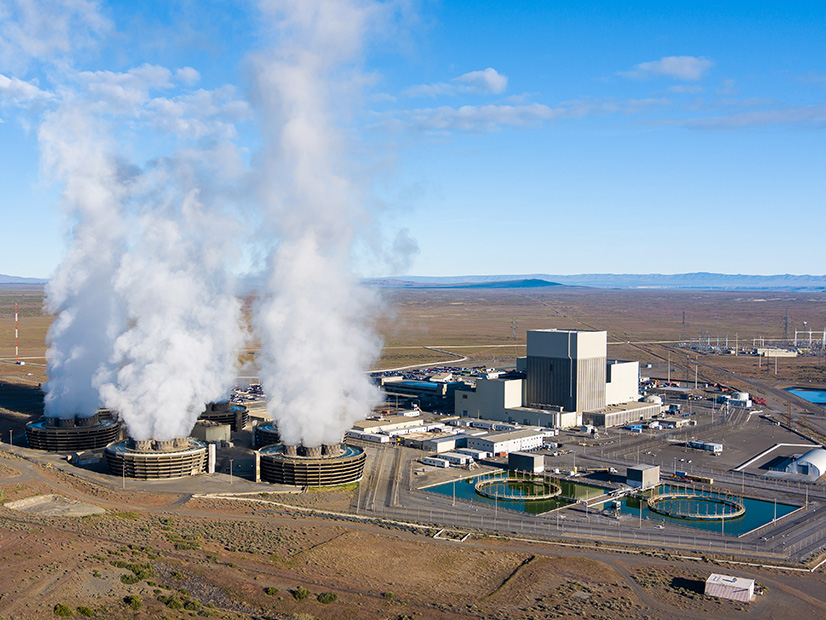
X-energy and Energy Northwest will partner on the development of up to 12 of X-energy’s Xe-100 small modular reactors to be located at a site in Central Washington, according to a Wednesday announcement from the two companies.
Under the joint development agreement, the 80-MW SMRs will come online in phases near Energy Northwest’s Columbia Generating Station, a 1,207-MW nuclear reactor 10 miles north of Richland, Wash. The first of the reactors is scheduled for completion by the end of 2030, with additional reactors added after, based on demand, according to Jason Herbert, Energy Northwest’s senior director for external strategy.
The company intends to apply to the Nuclear Regulatory Commission to license 12 reactors even though “right now, based on our utility, interest and offtake, we’re looking at probably … a four- to eight-module plant to start with,” Herbert said in an interview with NetZero Insider. “But we want to license for 12, so that in the future, let’s say, a utility comes to us and says, ‘Hey, we need 160 MW in three years.’ We can add in two more.”
If all 12 were built, the total capacity would be 960 MW, according to the announcement.
Energy Northwest is a Washington state public power joint operating agency, providing electricity to 28 public power utilities in the state. Other generation includes hydroelectric, wind and solar, and storage.
“As the Northwest region of the United States pursues a future clean energy grid, it is clear it will need new sources of dependable, carbon-free power,” said Bob Schuetz, CEO of Energy Northwest. “X-energy’s Xe-100 advanced reactor technology possesses many attributes ideally suited to a carbon-constrained electric system, and this agreement reflects our determination to deliver the technologies to meet growing clean energy needs.”
Under the Clean Energy Transformation Act (SB 5116) signed in 2019, Washington is committed to a carbon-free electric power system by 2045.
For X-energy, the announcement represents a critical step in building a pipeline of projects for the Xe-100, which the company has developed with $1.1 billion in funding from the Infrastructure Investment and Jobs Act as part of the Department of Energy’s Advanced Reactor Demonstration Program.
The program is supporting two advanced reactor demonstrations, the Xe-100 and the Natrium reactor developed by TerraPower, the company started by Microsoft founder Bill Gates.
The Xe-100 is a high-temperature, gas-cooled reactor, which uses small “pebbles” of graphite-covered nuclear fuel and can produce steam for high-heat industrial processes, with temperatures of 750 degrees Celsius, or close to 1,400 degrees Fahrenheit. At 80 MW, the X-energy reactor is designed to be modular so two or more units can be combined for heat or power or both.
As part of the DOE program, the company’s first four Xe-100s will be sited at a Dow Chemical plant on the Texas Gulf Coast, where they will be used to provide the high-temperature process heat the company needs to produce chemicals. The Dow reactors are being built to provide both power and high-temperature process heat, which X-energy will be able to use in Washington, said Ben Reinke, X-energy’s vice president of global business development.
Speaking at an industrial decarbonization event in Washington, D.C., on Wednesday, Reinke said the Energy Northwest reactors are being planned as “most likely [an] all-electric play. However, when you have low-cost electricity, you start to draw a lot of industry to the area. So, I think what we’ll see over time is an ecosystem built around energy units in Central Washington, hopefully decarbonizing not only electricity, but also potentially process heat as well.”
On Time, on Budget
The challenge ahead for X-energy is delivering its projects for both Dow and Energy Northwest on time and on budget — a goal the U.S. nuclear industry has yet to achieve.
The 92 reactors currently online in the U.S. provide 20% of the country’s power and 50% of its carbon-free power, and both the industry and the Biden administration are framing nuclear energy as an essential source of firm, dispatchable, carbon-free power.
But the only new reactors built in the U.S. in the past decade are Southern Co.’s two Vogtle nuclear plants in Georgia, which are now seven years behind schedule, with a cost that has ballooned from $14 billion to more than $30 billion. The first unit, Vogtle 3, was scheduled to come online in June, but encountered yet another delay due to a problem in the hydrogen system used to cool the main electrical generator, according to an Associated Press report.
Reinke said X-energy is trying to plan ahead to avoid delays and cost overruns. For the Dow project, the company is “fully designing our reactor before we break ground on construction, something the nuclear industry has never done before,” he said. “For example, we brought key partners in on the design of components and systems. We’ve gone ahead and made awards early on, earlier than a typical project might, to be able to bring into our final design period in the process these key partners who will ultimately be manufacturing the components and systems to make sure that what we’re designing is something they can manufacture.”
X-energy has also included construction teams in the design process to ensure a workable “construction laydown plan,” Reinke said.
Fuel for the Xe-100 is yet another challenge. Like other advanced reactors, the Xe-100 uses high-assay, low-enriched uranium (HALEU). The U.S. has historically depended on Russia for HALEU, but in the wake of the Russian invasion of Ukraine, it is working on standing up a domestic supply chain.
X-energy expects it will get the fuel it needs for the Dow project from DOE, Reinke said. He pointed to DOE’s HALEU Availability Program, which received $700 million from the Inflation Reduction Act to spur development of a domestic supply chain.


